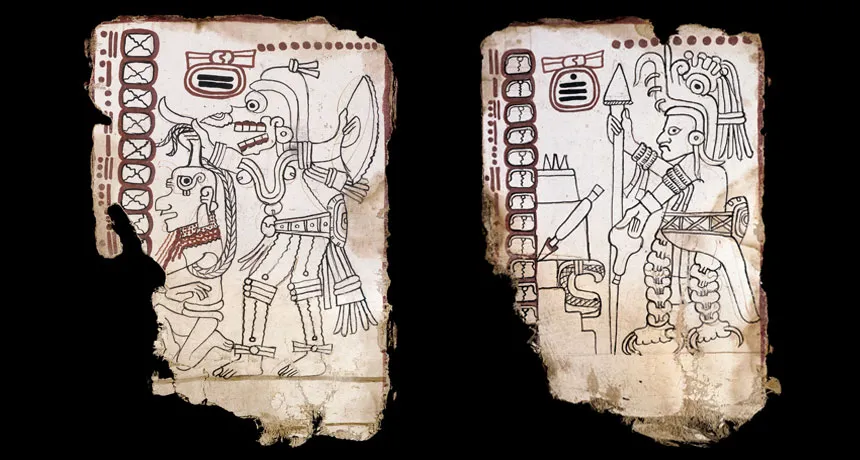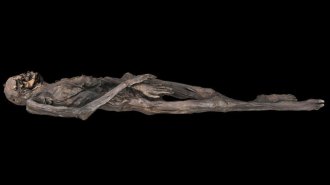Ancient Maya codex not fake, new analysis claims
If authentic, Grolier text could claim spot as oldest book in Americas

GENUINE GODS A book called the Grolier Codex — once regarded as a fake by some scientists — may be the oldest known manuscript of ancient America. Deities depicted on the book’s 10 surviving pages include a death god with a decapitated captive (left) and a bird/serpent god.
Enrico Ferorelli, S. Houston
A bark-paper document with a weird backstory and once suspected to be a forgery is the real deal, researchers say. If true, that increases the likelihood that the plaster-coated book covered with painted images and writing is the earliest known manuscript from ancient America, dating back to the 13th century.
No forger could have known how to reproduce all the bookmaking techniques, colored inks and deities pictured in what’s known as the Grolier Codex, concludes a team of researchers who specialize in the Maya and other ancient American societies. For instance, an illustration of a mountain god includes a flaring, cleft head or headdress. Other images of this god were first discovered at Maya sites several decades after the Grolier Codex turned up in the 1960s.
“Even a good faker would not have known about the mountain god’s headdress,” says Maya researcher David Freidel of Washington University in St. Louis, who was not involved in the study.
John Carlson, a physicist and astronomer at the University of Maryland in College Park, has argued for the authenticity of the codex since the 1980s. He presented a summary of his research supporting that conclusion in a paper appearing in 2014 in the journal Archaeoastronomy.
The new analysis comes from Yale University’s Michael Coe and Mary Miller, Stephen Houston of Brown University and Karl Taube of the University of California, Riverside. Appearing in Maya Archaeology 3, a publication released September 7, the study is based on high-quality photographs of the book’s 10 surviving pages. The original Grolier Codex most likely included 20 attached pages that folded like an accordion, the researchers say. A few surviving pages are still attached to one another.
Drawn deities and written glyphs in the Grolier Codex display influences from the Maya site of Chichén Itzá on the Yucatán Peninsula and the Toltec site of Tula in central Mexico, the investigators say. Evidence of contacts between the Maya and Toltec societies dates to between the end of Classic Maya civilization around 950 and the arrival of Spanish explorers in the 1500s.
Two radiocarbon studies suggest that the book dates to the 1200s. One study, in 1973, tested uncoated bark paper found with the codex. A 2014 study, by Carlson, dated fragments from the codex itself.
“The Grolier Codex was probably made by one scribe who did not distinguish between the Toltec and the Maya,” Houston says. Fake Maya codices are ineptly done and easily spotted, he adds. “They are nothing like the Grolier Codex,” Houston contends, which displays a sophisticated understanding of both Maya and Toltec artistic styles and glyphs.
Three other Maya bark-paper manuscripts, dubbed the Dresden, Madrid and Paris codices for the cities where they’re housed, were discovered and authenticated by the mid-1800s (SN: 2/21/15, p. 14). Those codices were made before Spanish contact but lack radiocarbon ages.
Since its reported discovery in a southern Mexico cave by looters in the early 1960s, the Grolier Codex has aroused suspicions of fakery. A wealthy Mexican collector exhibited the document at New York City’s Grolier Club in 1971, giving the codex its name. The collector claimed that two looters had taken him by airplane to a remote spot where he was shown the book and other finds from the cave, including a wooden mask.
Another red flag was the Grolier Codex’s simple illustrations and glyphs. The three authenticated Maya codices feature elaborate notations, calculations and illustrations.
These surviving Maya codices were probably spared by Spanish authorities as special examples of New World culture to show Europeans, Houston says. By contrast, the Grolier Codex is a “run-of-the-mill” ritual guide of a type that the Spanish destroyed en masse, he suspects.
A calendar predicting the movements of the planet Venus over 104 years, with an undetermined start date, appears in the Grolier Codex. The number of days between Venus’ appearances as the morning star was used to time ritual events. Gods depicted in the Grolier Codex carry out demands of Venus related to the sun, death and other basic concerns.
The new analysis also supports the codex’s authenticity based on examination of previous reports of radiocarbon dates and colored inks in the Grolier Codex that probably include Maya blue (SN: 3/1/08, p. 134), which has a chemical signature that remained unknown until the 1980s, archaeologists Harvey and Victoria Bricker, both of Tulane University in New Orleans, wrote in an email to Science News. The Brickers agree that the Grolier Codex contains a mix of Maya and Central Mexican features.
Still, the document remains controversial. Susan Milbrath of the Florida Museum of Natural History in Gainesville, a longtime Grolier Codex skeptic, declined to comment on the new paper. But she emailed a 2007 paper suggesting that stains and jagged tears in some parts of the document were produced long after the 1200s, possibly in an effort to make the manuscript look older than it actually is. Plaster and ink erosion on the manuscript caused that damage, Houston says.
Editor’s note: This story was updated November 10, 2016, to include details on previous research supporting the authenticity of the codex, to clarify the description of Maya Archaeology 3 and to correct the description of the radiocarbon dating done in 1973.







